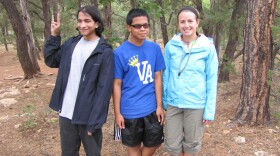Before becoming a national park, the remote western part of the Grand Canyon was a place where a handful of ranchers - with true grit - struggled to earn a living. To make things a little more comfortable, they opened a winter camp deep within the canyon. It was known as "The Hotel" and remains an occasional refuge for hikers. In his latest Grand Canyon Commentary, Scott Thybony tells us about the night he spent at "The Hotel"
Rain has fallen all day, and the clouds hide the canyon rim high above us. "It could be worse," says Tony Williams. "It hasn't progressed from the simply uncomfortable to the miserable yet." "We'll work on that," I tell him.
As the rain continues to fall, we decide to make an early camp below an overhanging cliff. The rock shelter, known as The Hotel, was used by cowboys before the western Grand Canyon became part of the national park. We find it stocked with a pair of metal beds, trail tools, and a kitchen set up with skillets and hanging pots. Every item of gear had to be packed in by rancher Al Craig and his wife, Mary.
They acquired the grazing rights to the area in the 1930's from a man who raised only horses. No one thought cattle could make it over the rough trail, but Al led a gentle milk cow along the switchbacks and the rest followed. And one time Mary carried down two buckets of eggs, individually wrapped in newspaper. On a steep pitch, she fell and slid a couple of feet while raising the buckets over her head to save the fragile cargo. The Craigs ran their cattle below the rim during the winter months, and in times of drought took desperate measures to keep them alive. Using a propane torch, Al burned the spines from prickly pear cactus, and the cows developed such a taste for it they came running whenever they saw the smoke.
After hanging up damp clothes to dry I look inside a metal-lined trunk filled with cooking gear, a Readers Digest from 1950, Zane Grey's Western Magazine, and a manual of native grasses. Without knowing where to find grass, your cows suffer, and without Zane Grey to take you beyond all the drudgery and danger, you lose heart. Survival here required knowledge of the land, but it also required connecting with a wider pattern outside yourself.
Glad to be out of the rain for the evening, our hiking companion Mary Allen comments on our first-class accommodations. "The only thing missing," she says, "are the chocolate mints on the pillow." After dark, a square of chocolate appears on the stuff sack she uses as a pillow, ensuring The Hotel's high reputation.
Next morning we head back to the rim. As we walk, Mary relates a story she heard from the Craigs about a half-crazed hermit known as the Red Angel. Dressed in greasy buckskins with a long, red beard, the poacher raised suspicions by hiding out in the canyons. Those living on isolated ranches considered him dangerous. One night, Al Craig left his camp at The Hotel and began walking under a full moon up what he called S.O.B. Canyon. He kept hearing footsteps behind him and was afraid it might be the Red Angel stalking him. Every time he stopped, the footsteps stopped. He ducked into the shadow of a cliff, picked up a rock, and waited. The footsteps began again, and Al raised the rock above his head ready to defend himself. Suddenly, a dark form came around the corner, and he recognized a pair of long ears. His mule had broken loose and followed him from camp.
Back on top we find 8 inches of snow covering the ground, and it soon turns to mud on the long drive back. John Riffey, the Tuweep ranger for many years, had some advice for those traveling the backroads: "Never wash the mud off a truck," he said. "That's what holds it together."







